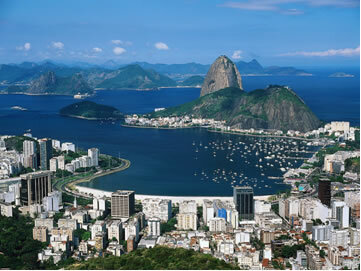With a territorial extension of 43,780.157 square kilometers, Rio de Janeiro is the smallest state in the Southeast Region. According to the population count carried out in 2010 by the Brazilian Institute of Geography and Statistics (IBGE), the State population totals 15,989,929 inhabitants, with a demographic density of 365.2 inhabitants per kilometer square.
The territory that currently corresponds to Rio de Janeiro was inhabited by several indigenous tribes: Tupinambás, Goitacá, Guaianás, Tamoios, Botocudo, Tupiniquins, among others. During the colonization process, Rio de Janeiro received Portuguese, French, and African slaves. Later, the state was also a destination for migratory flows from Switzerland, Germany, Italy, Spain, etc.
Rio de Janeiro has experienced an extraordinary population increase over the years and is currently the third most populous state in Brazil. Its more than 15.9 million inhabitants are distributed in 92 municipalities. The city of Rio de Janeiro, state capital, is the most populous: 6,320,446 inhabitants. Other municipalities in the state with high population concentration are: São Gonçalo (999,728), Duque de Caxias (855,048), Nova Iguaçu (796,257), Niterói (487,562) and Belford Roxo (469,332).
With a Human Development Index (HDI) of 0.832, Rio de Janeiro occupies 4th place in the national HDI ranking. The literacy rate is the third highest in the country (96%), behind only Amapá (97.2%) and the Federal District (96.6%). Rio de Janeiro has the second best average of schooling in Brazil: 45.6% of its population has eight years or more of schooling.
Most of the population lives in urban areas: 96.7%, which makes Rio de Janeiro one of the most urbanized states in Brazil. Environmental sanitation services serve 84.6% of Rio de Janeiro households. The infant mortality rate is 18.3 deaths per thousand live births, below the national average, which is 22.

Rio de Janeiro
Despite all these positive socioeconomic aspects, the state of Rio de Janeiro suffers from violence. The frequent armed conflicts between drug dealers and police cause several deaths, in addition to causing a climate of insecurity for the population. According to data from the National Secretariat for Public Security, of the Ministry of Justice, Rio de Janeiro is the Brazilian state that has the highest number of deaths resulting from crimes in the country.
Data on the population of Rio de Janeiro:
Population: 15,989,929 inhabitants.
Density: 365.2 inhabitants per square kilometer.
Demographic growth: 1.1% per year.
Urban population: 96.7%.
Rural population: 3.3%.
Illiteracy: 4%
Functional illiteracy: 14.1%.
Access to water: 88.1%.
Access to the sewage network: 84.6%
Infant mortality: 18.3 deaths per thousand live births.
Intentional homicides (with intent to kill): 33 per 100,000 population.
______________________
Image credits: dabldy / shutterstock
By Wagner de Cerqueira and Francisco
Graduated in Geography
Brazil School Team
Rio de Janeiro - Southeast region
geography of Brazil - Brazil School
Source: Brazil School - https://brasilescola.uol.com.br/brasil/aspectos-populacao-estado-rio-janeiro.htm
